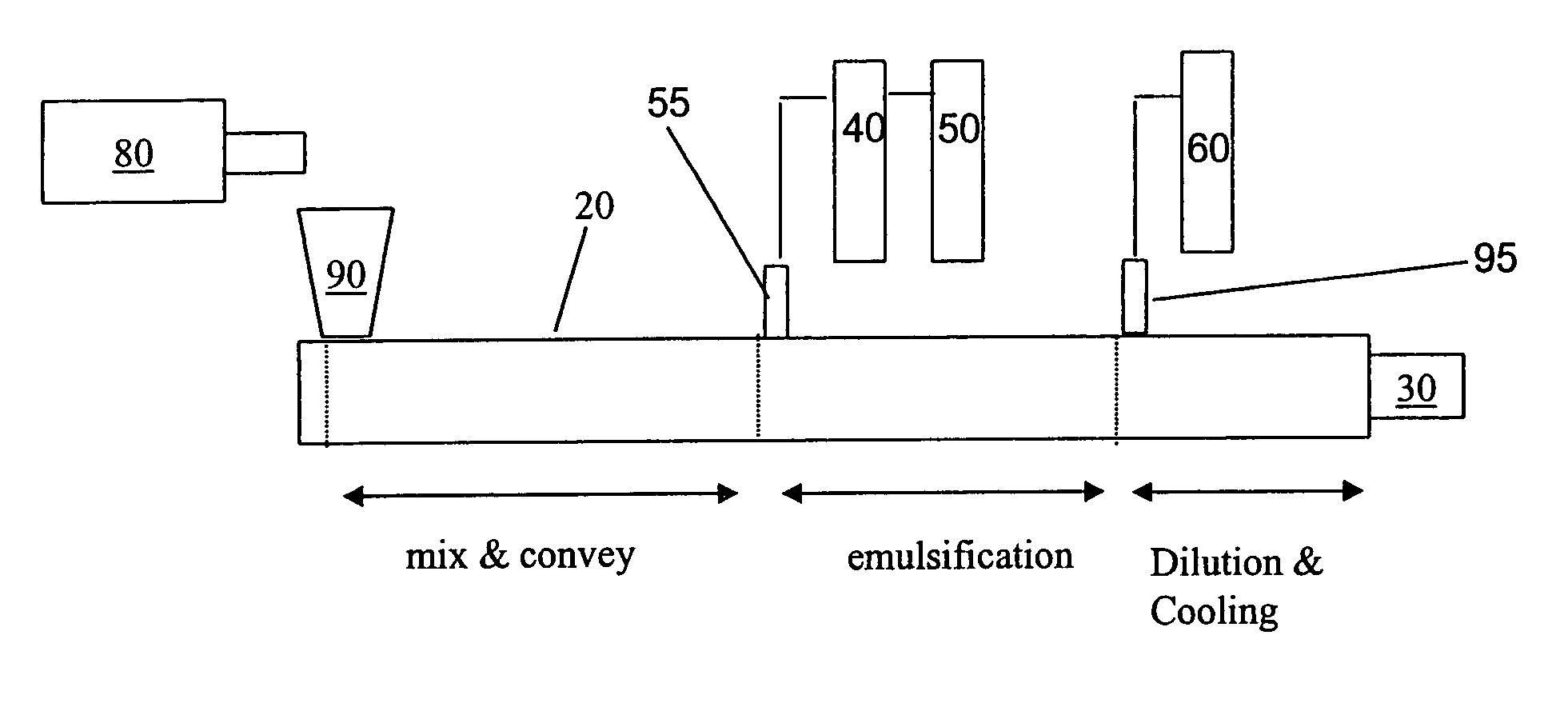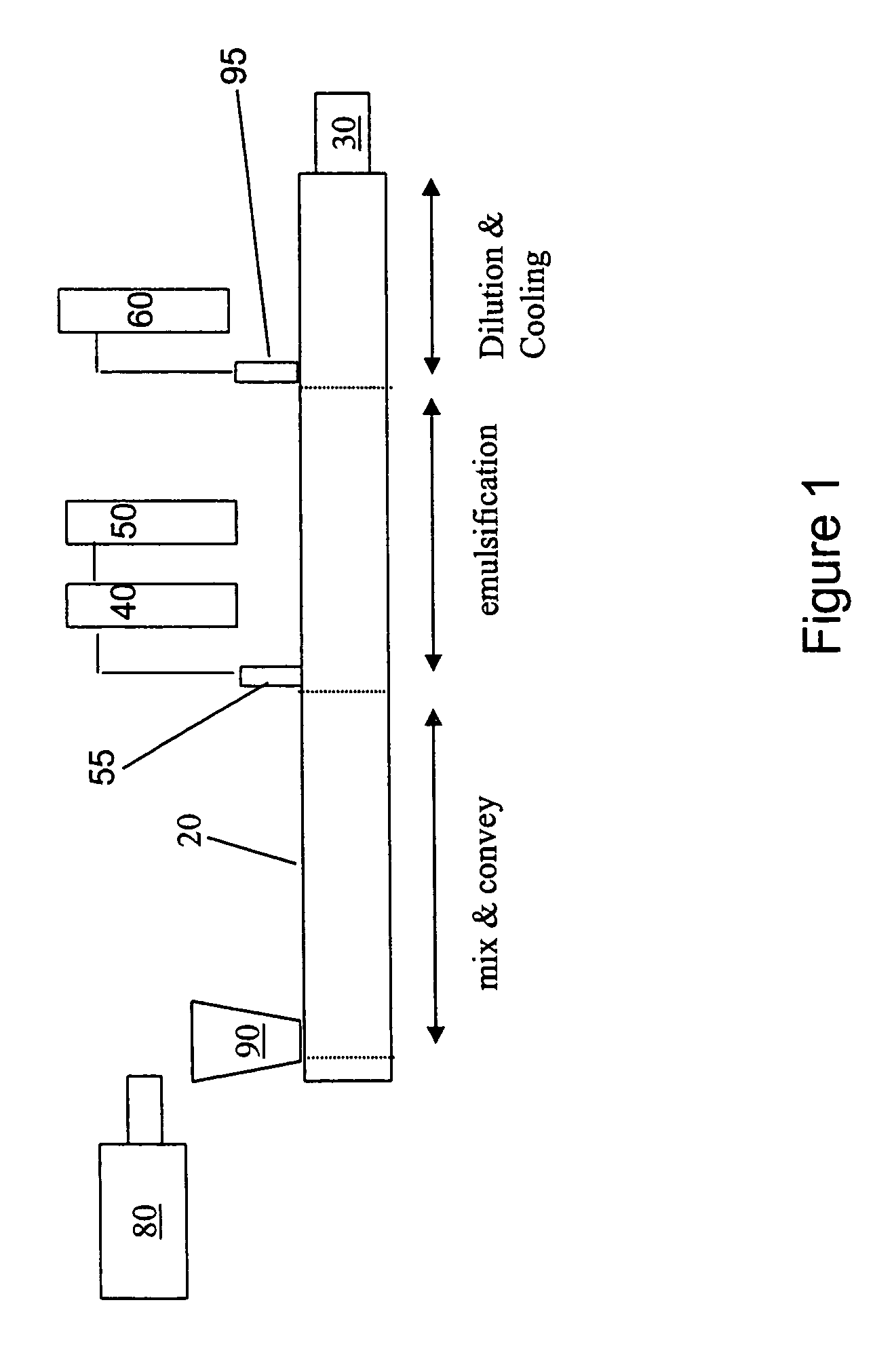Aqueous polymer dispersions and products from those dispersions
a technology of aqueous polymer and dispersions, which is applied in the direction of synthetic resin layered products, tyre parts, vehicle components, etc., can solve the problems of complex equipment, limited range of thermoplastic resin aqueous dispersions that can be produced, and complicated control of the polymerization reaction
- Summary
- Abstract
- Description
- Claims
- Application Information
AI Technical Summary
Problems solved by technology
Method used
Image
Examples
preparation example 1
[0110]100 parts by weight of a thermoplastic ethylene-vinyl acetate commercially available from DuPont having a vinyl acetate content of about 28 wt %, a density of about 0.95 g / cm3 (ASTM D-792) and a melt index of about 6 g / 10 min. (as determined according to ASTM D1238 at 190° C. and 2.16 kg), and a melting point of about 73° C. (as determined according to ASTM D3417) and 4.2 parts by weight of a C32 carboxylic acid (Unicid 425 manufactured by Baker-Petrolite, acid value 97 mg KOH / g) are melt kneaded at 180° C. in twin screw extruder at a rate of 8.3 kg / hr.
[0111]Upon the melt kneaded resin / surfactant, 4.6 wt % aqueous solution of potassium hydroxide is continuously fed into a downstream injection port at a rate 0.9 kg / hr (at a rate of 10 wt % of the total mixture). This aqueous dispersion is subsequently diluted with additional water at a rate of 5.7 kg / hr before exiting the extruder. An aqueous dispersion having a solids content of 56 wt % at pH 10.7 is obtained. The dispersed po...
preparation example 2
[0112]100 parts by weight of a thermoplastic ethylene / 1-octene copolymer with an octene content of about 38 wt %, a density of about 0.87 g / cm3 (ASTM D-792) and a melt index of about 5 g / 10 min. (as determined according to ASTM D1238 at 190° C. and 2.16 kg) a Mw / Mn of about 2.0, and a melting point of about 63° C. (as determined by DSC at a scanning rate of about 110° C. per minute), commercially available from DuPont Dow Elastomers, and 3.1 parts by weight of a C18 / C16 carboxylic acid (Industrene 106 manufactured by CK Witco, acid value 200 mg KOH / g) are melt kneaded at 125° C. in twin screw extruder at a rate of 7.9 kg / hr.
[0113]Upon the melt kneaded resin / surfactant, 23.9 wt % aqueous solution of potassium hydroxide is continuously fed into a downstream injection port at a rate 0.2 kg / hr (at a rate of 2.5 wt % of the total mixture). This aqueous dispersion is subsequently diluted with additional water at a rate of 5.4 kg / hr before exiting the extruder. To further dilute the result...
preparation example 3
[0114]100 parts by weight of a thermoplastic ethylene / 1-octene copolymer with octene content of about 38 wt %, a density of about 0.87 g / cm3 (ASTM D-792) and a melt index of about 5 g / 10 min. (as determined according to ASTM D1238 at 190° C. and 2.16 kg) a Mw / Mn of about 2.0, and a melting point of about 63° C. (as determined by DSC at a scanning rate of about 10° C. per minute.), commercially available from DuPont Dow Elastomers, and 3.6 parts by weight of a C22 / C18 carboxylic acid (High-erucic rapeseed oil manufactured by Montana Specialty Mills, acid value 97 mg KOH / g) are melt kneaded at 150° C. in twin screw extruder at a rate of 5.0 kg / hr.
[0115]Upon the melt kneaded resin / surfactant, 16.3 wt % aqueous solution of potassium hydroxide is continuously fed into a downstream injection port at a rate 0.1 kg / hr (at a rate of 2.0 wt % of the total mixture). This aqueous dispersion is subsequently diluted with additional water at a rate of 3.2 kg / hr before exiting the extruder. To furt...
PUM
| Property | Measurement | Unit |
|---|---|---|
| melting point | aaaaa | aaaaa |
| density | aaaaa | aaaaa |
| density | aaaaa | aaaaa |
Abstract
Description
Claims
Application Information
 Login to View More
Login to View More - R&D
- Intellectual Property
- Life Sciences
- Materials
- Tech Scout
- Unparalleled Data Quality
- Higher Quality Content
- 60% Fewer Hallucinations
Browse by: Latest US Patents, China's latest patents, Technical Efficacy Thesaurus, Application Domain, Technology Topic, Popular Technical Reports.
© 2025 PatSnap. All rights reserved.Legal|Privacy policy|Modern Slavery Act Transparency Statement|Sitemap|About US| Contact US: help@patsnap.com



